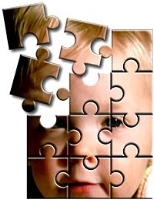Pawan Sinha, assistant professor of visual neuroscience at MIT, wonders if autistic individuals simply don't see what others see, focusing on details and losing sight of the whole.
Sinha is one of three promising young scientists in the United States who recently received a four-year fellowship from the John Merck Scholars Program in the biology of developmental disabilities in children. The Merck Scholars receive $300,000 apiece over four years to support their research. Sinha plans to use the Merck fellowship for his work on characterizing and improving face processing skills in children with autism and those who have suffered extended periods of visual deprivation.
Autism is a complex developmental disability that typically appears during the first three years of life. The result of a neurological disorder, autism is four times more prevalent in boys than girls and knows no racial, ethnic or social boundaries. As many as 1.5 million Americans are believed to have some form of autism, according to the Autism Society of America. That number is growing at a rate of 10-17 percent per year.
Autistic children typically have trouble maintaining eye contact and reading social cues such as facial expression, body posture and gestures. Sinha is exploring whether autistic children have impaired face perception skills and is developing a methodology called VisTA (Visual Training and Assessment) to help them refine those skills.
Through collaborations with Children's Hospital in Boston and the OpenDoor Center for Autistic Children in New Delhi, India, the first specialized school for children with autism in South Asia, Sinha plans to administer tests to several autistic individuals over the coming two years. The tests will simultaneously determine whether the children have trouble seeing faces and help them bring disparate visual elements together into a comprehensible whole.
"We are focusing on a hallmark deficit of autism--difficulties in social interactions," Sinha said. "Most person-to-person interactions require an exchange and interpretation of subtle facial cues. It is conceivable that an inability to effectively process facial signals would manifest itself as an impairment in social skills. We want to find out what visual processing deficits might lead to problems in face perception."
If visual processing by the brain is the problem, this would have significant implications for the design of treatment programs. VisTA is intended to be one such program. "We believe that this procedure, when conducted with children with autism, might mitigate their tendency to rely on fragmentary information and improve their ability to use overall facial configuration," Sinha said.
Sinha believes that conducting some of these studies in India as well as in the United States can accomplish important objectives. "We hope to bring some much-needed attention to the problem of autism in India, where the number of affected children is estimated to be more than 2 million. Public awareness and government resources directed toward it are almost nonexistent," he said. "We hope to improve the quality of life for many children with autism in India who may otherwise be treated as social outcasts. And we hope that these studies, whether in the United States or India, will eventually help mitigate the toll that this disorder exacts on the lives of many children and their families all over the world."






